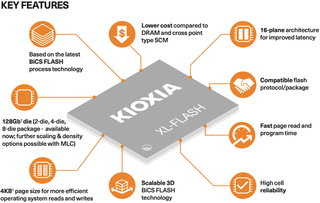Kioxia Unveils 2nd Gen XL-Flash Storage Class Memory for Ultra-High-End SSDs
Kioxia's 2nd gen low-latency XL-flash for high-end SSDs goes MLC

Kioxia has introduced its 2nd Generation XL-Flash storage class memory (SCM), which combines low latency, high performance, and capacity of 3D NAND flash. The new memory devices are designed for ultra-high-end solid-state drives as well as various CXL memory extender devices that have to offer both decent performance and non-volatility.
Kioxia's 2nd Gen XL-Flash substantially differs substantially from existing XL-Flash devices. First up, the new XL-Flash adopts multi-level cell (MLC) architecture that stores two bits per cell (2bpc) as opposed to existing XL-Flash that uses single-level cell (SLC) architecture. Usage of MLC enabled Kioxia to increase capacity of a single 2nd Gen XL-Flash device to 256GB (32GB), which enables it to build XL-Flash chip packages of up to 2048Gb (256GB) using up to eight ICs.
Secondly, because MLC has higher latency than SLC, Kioxia had to increase the number of planes per device to ensure higher access parallelism to boost peak throughput and to partly compensate for increased latency. The original XL-Flash used shorter bit lines and word lines to build 16 planes per device (i.e., significantly more than two or four planes used by contemporary 3D NAND devices for client PCs) in a bid to boost performance. Anyway, the number of planes per 2ndGen XL-Flash IC is higher than the number of planes per 1st Gen XL-Flash IC (i.e., more than 16 planes), so it is reasonable to expect increased bandwidth per device.

Kioxia promises that its 2nd Generation XL-Flash storage class memory will provide higher performance than its 1st Gen XL-Flash SCM at lower per-bit cost. Furthermore, it will allow for building of higher-capacity drives. For now it does not look like Kioxia plans to wind down production of SLC XL-Flash, so those who need such memory will be able to buy it. Meanwhile, 2nd Gen XL-Flash is aimed primarily at CXL-enabled SSDs and memory expanders, so they promise to have an edge over existing PCIe/NVMe drives in applications that require low latencies.
Kioxia says that it will begin shipments of 2nd Gen XL-Flash samples this November with volume production set to kick off in 2023.
Stay On the Cutting Edge: Get the Tom's Hardware Newsletter
Get Tom's Hardware's best news and in-depth reviews, straight to your inbox.

Anton Shilov is a Freelance News Writer at Tom’s Hardware US. Over the past couple of decades, he has covered everything from CPUs and GPUs to supercomputers and from modern process technologies and latest fab tools to high-tech industry trends.
-
2Be_or_Not2Be Low-latency benefit, huh? I wish Kioxia, Samsung, or SK Hynix (well, they bought Intel's NAND flash biz) had bought Optane storage from Intel & kept on developing it. Low-latency was never a problem with Optane/3DXpoint.Reply -
bit_user Reply
I say this as a fan of Optane and someone who wanted (still wants) an Optane SSD for my PC: I think what killed Optane is that they simply could not come anywhere close to competing on price.2Be_or_Not2Be said:I wish Kioxia, Samsung, or SK Hynix (well, they bought Intel's NAND flash biz) had bought Optane storage from Intel & kept on developing it. Low-latency was never a problem with Optane/3DXpoint.
And I don't know enough about the underlying technology, but it's entirely possible that Optane simply doesn't scale down well. I expect that if the technology truly had legs, then someone would've picked up the assets if Intel were simply unwilling or unable to continue investing in it.
Most Popular



